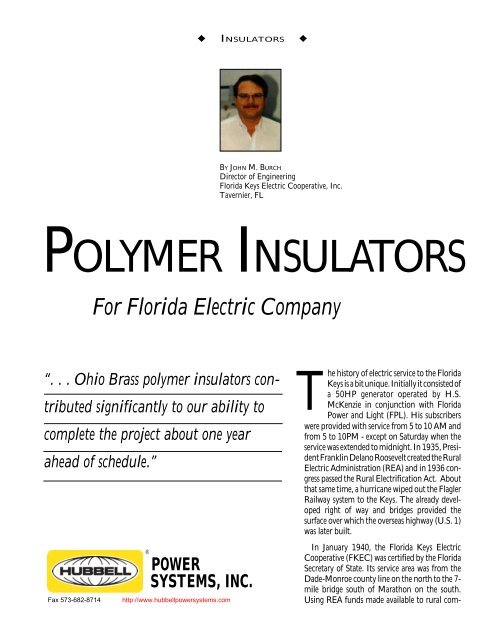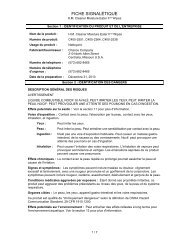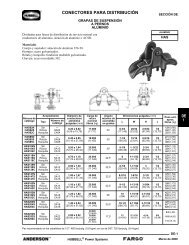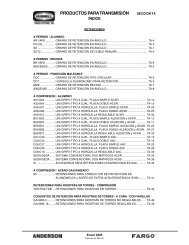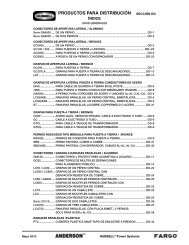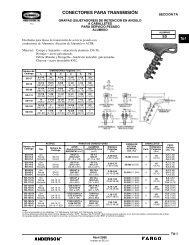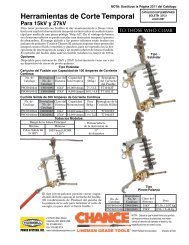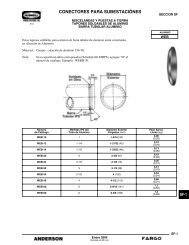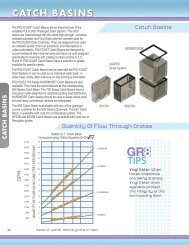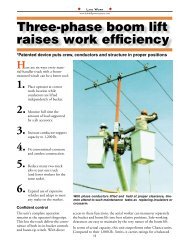POLYMER INSULATORS - Hubbell Power Systems
POLYMER INSULATORS - Hubbell Power Systems
POLYMER INSULATORS - Hubbell Power Systems
Create successful ePaper yourself
Turn your PDF publications into a flip-book with our unique Google optimized e-Paper software.
♦ <strong>INSULATORS</strong> ♦<br />
BY JOHN M. BURCH<br />
Director of Engineering<br />
Florida Keys Electric Cooperative, Inc.<br />
Tavernier, FL<br />
<strong>POLYMER</strong> <strong>INSULATORS</strong><br />
For Florida Electric Company<br />
“. . . Ohio Brass polymer insulators con-<br />
tributed significantly to our ability to<br />
complete the project about one year<br />
ahead of schedule.”<br />
®<br />
POWER<br />
SYSTEMS, INC.<br />
Fax 573-682-8714 http://www.hubbellpowersystems.com<br />
The history of electric service to the Florida<br />
Keys is a bit unique. Initially it consisted of<br />
a 50HP generator operated by H.S.<br />
McKenzie in conjunction with Florida<br />
<strong>Power</strong> and Light (FPL). His subscribers<br />
were provided with service from 5 to 10 AM and<br />
from 5 to 10PM - except on Saturday when the<br />
service was extended to midnight. In 1935, President<br />
Franklin Delano Roosevelt created the Rural<br />
Electric Administration (REA) and in 1936 congress<br />
passed the Rural Electrification Act. About<br />
that same time, a hurricane wiped out the Flagler<br />
Railway system to the Keys. The already developed<br />
right of way and bridges provided the<br />
surface over which the overseas highway (U.S. 1)<br />
was later built.<br />
In January 1940, the Florida Keys Electric<br />
Cooperative (FKEC) was certified by the Florida<br />
Secretary of State. Its service area was from the<br />
Dade-Monroe county line on the north to the 7mile<br />
bridge south of Marathon on the south.<br />
Using REA funds made available to rural com-
munities, an electric distribution system was built. Progress<br />
was slowed by the demand for war material although the<br />
Keys benefited from the war when the Navy built a water line<br />
all the way to Key West. The stage was set for rapid growth<br />
with a roadway to access the Keys, an electric system and an<br />
adequate water supply.<br />
The FPL/McKenzie holdings were purchased in 1941 and<br />
in 1942 a power plant was built in Tavernier. Marathon<br />
relied on a portable generator. From this evolved the system<br />
as it exists today. It is important to note that the FKEC is not<br />
only a distribution cooperative but has 16.5MW of generation<br />
and extensive transmission facilities.<br />
The transmission system got started in 1956 when a 69kV<br />
line was built from Tavernier to Florida City on the mainland.<br />
The FKEC then purchased power from the city of<br />
Homestead and later from FPL. The line paralleled U.S. 1<br />
and FKEC built the line from Florida City to Jewfish, then<br />
from Jewfish to Tavernier. In addition, a 69kV cable was<br />
installed between Tavernier and Islamorada. The first effort<br />
to establish overhead transmission between Marathon and<br />
Tavernier met with disaster when a line to Coco Plum was<br />
immediately destroyed by hurricane Donna in 1960.<br />
To keep up with growing demand, construction for a new<br />
138kV line began in 1975. The new line went from Key<br />
Largo to the Card Sound Bridge on state route 905 where it<br />
tied into FPL. About five years later, the old 69kV line from<br />
Key Largo to Tavernier was upgraded to 138kV and a new<br />
section was built from Tavernier to Marathon. This line was<br />
designed for 217MW but voltage considerations limit us to<br />
about 180MW. Capacitors have already been added.<br />
Text continues ➥
The joint FKEC<br />
— City Electric System<br />
of Key West<br />
(CES) transmission<br />
system had its inception<br />
in 1985 when the<br />
CES built a 138kV line<br />
and tied into the FKEC<br />
at Marathon. An agreement<br />
was reached<br />
whereby CES could get<br />
as much as 50MW if it<br />
was available. However the<br />
demand continued to grow<br />
and it became clear that it<br />
would be necessary to beef<br />
up the transmission facilities<br />
for the entire Florida<br />
Keys. In 1991 a plan calling<br />
for joint ownership of the<br />
transmission system was<br />
evolved. The percentage of<br />
ownership and the allocation<br />
of transferred energy were defined<br />
in the contract.<br />
The plan called for replacing<br />
the 69kV line from Key Largo<br />
to the county line with a new<br />
138kV line. This line would<br />
then proceed south to Tavernier<br />
where a new four breaker ring<br />
bus substation would be built.<br />
The line would be designed for<br />
230kV but operated at 138kV<br />
and FPL agreed to upgrade their<br />
tie line to 230kV. This would<br />
provide FKEC with a loop feed<br />
to Tavernier. All this was to be<br />
completed by 1996.<br />
In August 1992 hurricane Andrew<br />
severely damaged the existing 138kV line and essentially<br />
destroyed the old 69kV line. It was imperative that the whole<br />
plan be put on a fast track with completion now scheduled for<br />
early 1995. Expediting the permits presented special problems<br />
because the line is in an area of environmentally sensitive<br />
mangroves and adjacent to the Everglades National Park. The<br />
switchyard in Tavernier was proposed for construction in the<br />
area of a sensitive hardwood hammock. After much debate and<br />
some compromise, the permits were finally issued. After<br />
hurricane Andrew it was decided to design the line for a<br />
maximum effective wind speed of 172 mph at the pole top!<br />
The CES and FKEC retained the Maguire Group in<br />
Foxborough, MA to do the line<br />
design. The new line was to<br />
have a capacity of 360MW<br />
but once again voltage limitations<br />
have limited us to about<br />
220MW until corrective measures<br />
were taken. It was to be<br />
built in two phases. Phase 1<br />
was 7.5 miles long and went<br />
north from the Jewfish substation<br />
in Key Largo to the<br />
Dade-Monroe county line<br />
where it tied to FPL. Phase 2<br />
was about 15 miles long and<br />
extended south from Jewfish<br />
sub to the new<br />
switchyard at Tavernier.<br />
A single pole line of steel<br />
and spun concrete was chosen.<br />
Since it was designed<br />
for later upgrading to<br />
230kV, the insulator selected<br />
had to be such as<br />
to provide adequate<br />
leakage distance for operation<br />
at the higher<br />
voltage. This is important<br />
because during<br />
the long winter dry<br />
spells, the insulators<br />
accumulate a layer<br />
of surface contamination<br />
consisting<br />
largely of salt from<br />
the ocean spray.<br />
The Ohio Brass<br />
Hi*Lite XLHP<br />
horizontal post<br />
selected is equipped with 235<br />
inches of leakage distance or 1.685 inches per kV to<br />
ground at the maximum line to ground voltage for 230kV.<br />
This compares to 1.19 inches for a porcelain post.<br />
An additional advantage of the polymer post was its weight<br />
of only 130 pounds compared to a weight of 374 pounds for<br />
an equivalent porcelain insulator. The weight advantage becomes<br />
even more pronounced when you employ a braced post<br />
assembly on angle structures. In addition to the weight saving<br />
in the post, polymer suspensions weigh only 5 to 10 percent as<br />
much as porcelain suspensions.<br />
Insulator failures have occurred on the original 138kV line<br />
started in 1975. Investigation revealed that corrosion had taken<br />
place in the cement joints of these insulators. This deterioration
esulted in wind resonance fractures. Wind<br />
speeds in the Keys are consistently in the<br />
7.4 mph range — about the resonant<br />
wind speed for the porcelain posts on the<br />
line. The resulting oscillations caused the<br />
weakened insulators to fail in cantilever.<br />
A consultant was retained to recommend<br />
the line design tension and the type<br />
of insulator to be used on the new line.<br />
His study revealed that the line design<br />
tension should not exceed 18 percent of<br />
the conductor breaking strength. Since<br />
we preferred not to use vibration dampers,<br />
he recommended the use of polymer<br />
posts which he indicated would perform<br />
somewhat like dampers.<br />
The ability of the Ohio Brass ESP<br />
compound to withstand exposure to ultra<br />
violet light was demonstrated by the<br />
QUV test. This test which alternates<br />
exposure to UV and condensation during<br />
each cycle simulates the effect of<br />
sunlight by means of fluorescent UV<br />
lamps positioned within inches of the test<br />
specimen. The relative humidity is maintained<br />
at 100 percent. After the equivalent<br />
of approximately 25 years of exposure<br />
in the Arizona desert, the sample was<br />
still hydrophobic and there was no cracking,<br />
checking, crazing or erosion.<br />
Samples of the ESP compound were<br />
exposed to continuous corona. In addition,<br />
an oxidative stability test was conducted<br />
to determine its ability to withstand<br />
exposure to ozone. All test results<br />
revealed satisfactory characteristics.<br />
Another consideration was the inherent<br />
strength of the compound. The basic<br />
EPDM used in this alloy is physically<br />
much stronger than silicone rubber, as<br />
such, it is less likely to be damaged during<br />
handling and construction.<br />
Certainly our objective was to bring<br />
this project to fruition at minimum cost.<br />
This had to be tempered with the need to<br />
complete it without delay. The light<br />
weight and one piece construction of the<br />
polymer post simplified construction and<br />
resulted in lower construction costs.<br />
The removable base was attached to<br />
the pole before the pole was set. The<br />
insulator was then raised to the pole top<br />
by a bucket truck and remounted on its<br />
base. An equivalent porcelain post would<br />
require that the insulator be assembled<br />
on the ground. Due to the weight of the<br />
porcelain insulator, a crane would be<br />
required to raise it to the pole top. The<br />
© Copyright 2001 <strong>Hubbell</strong> • 210 North Allen Street • Centralia, MO 65240<br />
project contractor, Mr. Whitey Kohler of<br />
Kohler Construction, estimated that the<br />
installation time for the polymer post was<br />
only one-half the time for porcelain posts.<br />
In addition, the need for a crane on the job<br />
site resulted in the polymer post having a<br />
3 or 4 to 1 cost advantage over porcelain.<br />
As alluded to earlier, time was of the<br />
essence. We are convinced that the use of<br />
Ohio Brass polymer insulators contributed<br />
significantly to our ability to complete<br />
the transmission project about one<br />
year ahead of schedule. ■<br />
&<br />
TiPS NEWS<br />
view from<br />
Vol. 1, No. 5 November 1995<br />
NOTE: Because <strong>Hubbell</strong> has a policy of continuous product improvement, we reserve the right to change design and specifications without notice.<br />
EU1508-WB


